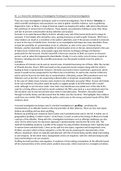AC 1.2: Assess the Usefulness of Investigative Techniques in Criminal Investigations
There are many investigative techniques used in criminal investigations. One of these is forensics, in
which scientific techniques and procedures are used to gather scientific evidence, such as gathering
fingerprints, hairs, or fibres. A range of forensic experts accompany the police, with whom they discuss
the usefulness of various forms of evidence. These experts use protective clothing to cover their shoes
and hair to prevent contamination during collection and analysis.
Forensics is so useful because DNA is found in virtually every cell of the human body and is unique to
everyone. It has helped solve old police cases, proving innocence as well as guilt. However, DNA from a
close relative can result in a conviction or the police’s attention, even if the person convicted is innocent,
as seen in the case of Collette Aram. Forensics as an investigative technique has many downfalls. These
include the possibility of contamination errors in collection, as seen in the case of Amanda Knox.
Similarly, another downfall is the possibility of contamination errors in the lab, demonstrated in the case
of Adam Scott. Furthermore, some people argue that forensic techniques infringe civil liberties –
particularly for the innocent. Another downfall is that trace amounts of DNA can convict an innocent
person, such as when this happened to David Butler. Finally, it is very costly. Lots of money is spent on
forensics, including not only the scientific procedures, but the people involved: from the police to
scientists.
A weakness of forensics can be seen in several cases, Amanda Knox being one of those. After the murder
of Miranda Kercher, Knox’s DNA was found on the suspected murder weapon along with the victim’s,
leading to Knox’s imprisonment. However, the knife was found in Knox’s boyfriend’s apartment, which
means it would not be unexpected for her DNA to be in his kitchen. As well as this, Kercher’s DNA was
said to only be found on the knife due to contamination. Ultimately, proper DNA procedures were not
followed, such as Kercher’s bra clasp being collected after so long that contamination was likely.
In the case of Colette Aram, forensics were shown to be ultimately successful. When 16-year-old Colette
Aram was murdered, the police urged the public to suggest people to be DNA tested with a mouth
swab, although no arrests were made. Years later, Paul Hutchinson was pulled over at the side of the
road for a driving offence and had his mouth swabbed. His DNA came back as a near identical match for
the murderer, but he had not yet been born when it had taken place. Therefore, the police looked
through his family history and discovered that his father was the murderer. This highlights how relatives
could have very similar DNA, meaning the police could come to the wrong conclusion based off the DNA
evidence alone.
A second investigative technique used in criminal investigations is profiling – predicting the
characteristics of an offender based on the characteristics of their offences. There are two main types:
bottom-up profiling and top-down profiling.
Bottoms-up profiling was created by David Canter and is predominantly used in the UK. It makes use of
geographical profiling, in which Canter’s ‘circle theory’ is used, as well as the timing of offences to build
a picture of the offender. Along with this, investigative techniques such as offender databases are also
used. On the other hand, the top-down approach is predominantly used by the FBI in the USA. This
method immediately produces a profile of the suspect by using intuitive techniques and is typically used
to narrow down potential leads. Crime can be split into two types: organised and disorganised crime.
Profilers can place which of these categories a crime fits into by analysing the characteristics of the
offence. Organised crimes are typically well-planned, with the criminals being socially adept and tending
to use weapons. On the other hand, disorganised crimes are impulsive, with the criminals being socially
inept and tending to not use weapons.
Profiling has both positives and negatives. A weakness is that making assumptions of the offender based
off the characteristics of the crimes alone could be inaccurate, which may lead to a wrongful conviction,





